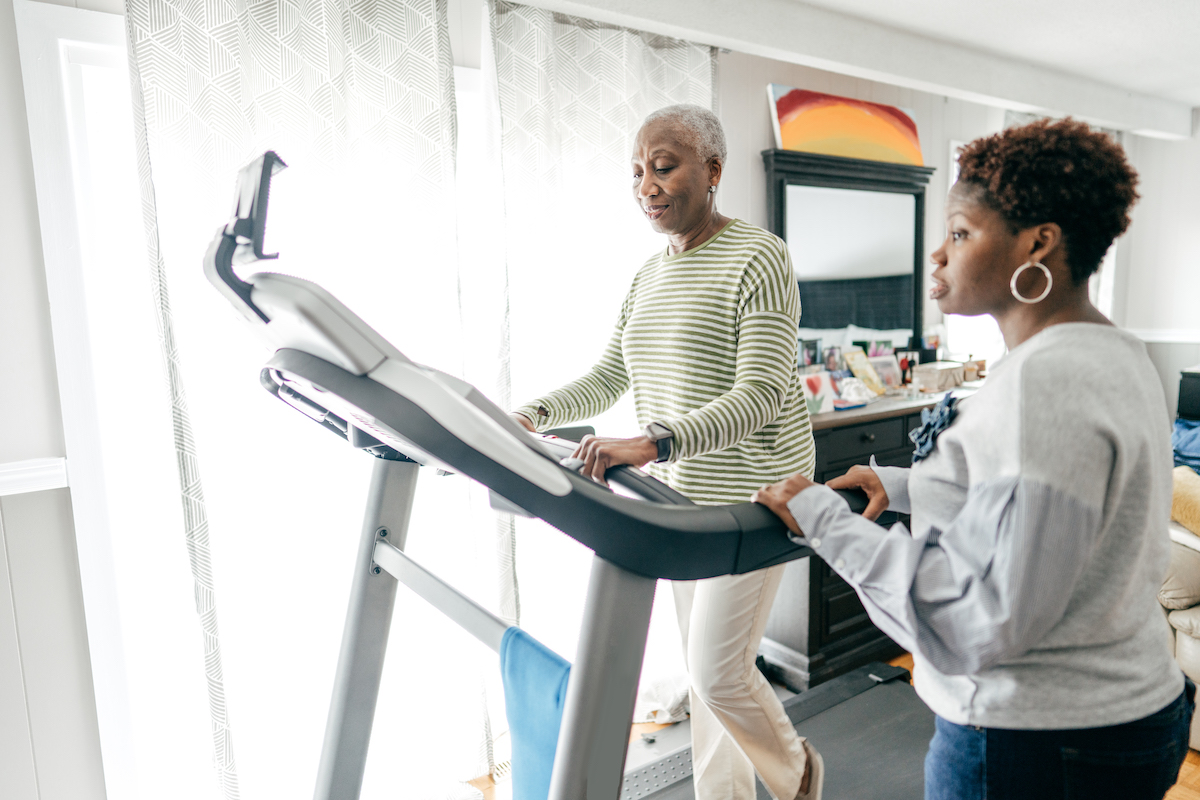Are HIIT Workouts the World’s Best Stress-Busting Exercise?
To work your body and clear your mind, you need to try HIIT workouts. Here’s where to start.

You already know that exercise can ease stress. In fact, some workouts, like yoga and tai chi, are famous for their calming effects. But which type of movement is the best stress-buster of all?
The research is in. The results have been tallied. The answer: high-intensity interval training, or HIIT.
During HIIT workouts, you do short bursts of heart-pounding work followed by brief recovery periods. The intensity pushes your heart rate to approximately 80% to 85% of its maximum, says Todd Astorino, Ph.D., a professor of kinesiology at California State University-San Marcos. This increased rate confers health benefits that slow-and-steady work can’t.
“If you jog for 30 minutes, you’re probably between 70% and 80% of your maximum heart rate, and that is going to be a pace that you can maintain,” says Astorino. “Once you get above 80% of maximum heart rate, you’re now into an intensity zone where you cannot maintain that effort for more than like a couple minutes without taking a break.”
Spiking your heart rate in short bursts, then recovering before repeating, trains your heart to do harder work and can lead to improved fitness, a higher calorie burn, and a calmer mind.
Here’s why: Intense exercise increases blood flow to your brain and encourages the growth of new nerve cells and neurons. Research even suggests that high-intensity interval training can help improve mental health and reduce symptoms of major depressive disorder in older adults, while boosting memory and adding other health benefits.
Ready to try HIIT? Take the five steps below. As with any workout, check with your doctor to make sure this plan is safe for you before you get started.
Emotional well-being and fitness go together! SilverSneakers classes and events are happening right now at participating gyms, online through SilverSneakers LIVE, and at community centers near you. Activate your free online account to get started.
Step #1: Find Your Maximum Heart Rate and Decide How You’ll Track It
To work hard but safely, start by estimating your maximum heart rate. The Centers for Disease Control and Prevention’s rule of thumb is to subtract your age from 220 to find your maximum heart rate. So let’s say, for example, that you are a healthy 70-year-old cleared by your doctor to try HIIT. Your estimated maximum heart rate is 150.
In HIIT, you’re aiming for 80% of your maximum during intense bouts. In this example, you would aim for a heart rate of 120. How will you know when you get there? If you have a smart watch or fitness tracker, it’s easy to keep tabs on your heart rate. If not, you can still get a pretty good estimate using the Borg Rating of Perceived Exertion, a tool exercise researchers have used for decades.
Gauge how hard you’re working on a scale from 6 to 20, with 6 representing no exertion at all and 20 representing your maximum. Add a zero to the end of your number, and you’ll have an estimate of your heart rate in beats per minute.
Another option is the talk test. If you can easily carry on a conversation while exercising, you probably haven’t hit your target heart rate for HIIT. See what it looks like here.
Step #2: Find Your Pace
Everyone’s starting point is different and depends on their fitness level. If you have access to a treadmill, try walking at a grade for about a minute to elevate your heart rate to the target zone, says Astorino. Then, walk on a flat level for another minute to a minute and a half.
In the recovery phase, your heart rate should be about 40% to 50% of your maximum, according to the American College of Sports Medicine. Repeat a total of six to eight times. As your fitness progresses, you might be able to run or sprint instead of walking.
Step #3: Add Variety
If you don’t have a treadmill, don’t enjoy using them, or can’t use one safely because of gait or balance problems, you have many other options. You can also do intervals by walking up and down hills or steps, cycling, spinning on a stationary bike, or using a rowing machine, says Astorino.
The type of activity itself isn’t important; HIIT is all about alternating between intensity and recovery to push your heart rate into the zone where you see the most health benefits. Again, aim for a minute of high intensity followed by 60 to 90 seconds of recovery, then repeat.
Recommended FREE SilverSneakers On-Demand Class: Interval Training Workout for Seniors
Step #4: Be Choosy About HIIT Classes
Some fitness classes billed as HIIT workouts don’t actually push your heart rate over 80% to 85% of its maximum, says Astorino. Those classes can still give you a great workout; they’re just misnamed. At the same time, some cardio classes and bootcamps may deliver a HIIT workout without saying so in the description.
Subscribe to our newsletter
It's quick and easy. You could be one of the 13 million people who are eligible.
Already a member? Click to discover our 15,000+ participating locations.
Follow Us
If your goal is to try intervals, look for a class that will actually push you to do intense, brief stints of work followed by recovery periods. And if you’re not sure if a class you’re interested in counts, ask the instructor.
Recommended 15-minute SilverSneakers LIVE class: Cardio Interval (Express)
Step #5: Keep Things in Perspective
You don’t have to do HIIT workouts every day. One to three days of HIIT per week is enough to be beneficial, and you can alternate it with other forms of training, like resistance workouts, says Astorino.
And if you find that HIIT just isn’t your thing and some other workout is a better stress reliever, no problem. After all, the best de-stressing workout is the one that you’ll actually do.
See our sources:
Link between HIIT and cognitive function in older adults: Brain Sciences
How to estimate your maximum heart rate: Centers for Disease Control and Prevention
Borg Rating of Perceived Exertion scale: Centers for Disease Control and Prevention
HIIT heart rate targets: American College of Sports Medicine
Check Your SilverSneakers Eligibility Instantly
SilverSneakers members can go to thousands of nationwide gyms and fitness locations, plus take SilverSneakers LIVE online classes that are designed for all fitness levels and abilities. If you have a Medicare Advantage plan, it may include SilverSneakers — at no additional cost. Check your eligibility instantly here.
Already a member? Get your SilverSneakers member ID and exclusive fitness and wellness content by activating your online account here.
Not eligible for SilverSneakers? You can still get 200+ free SilverSneakers On-Demand videos and stay in touch with us by creating your online account.





